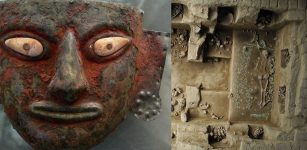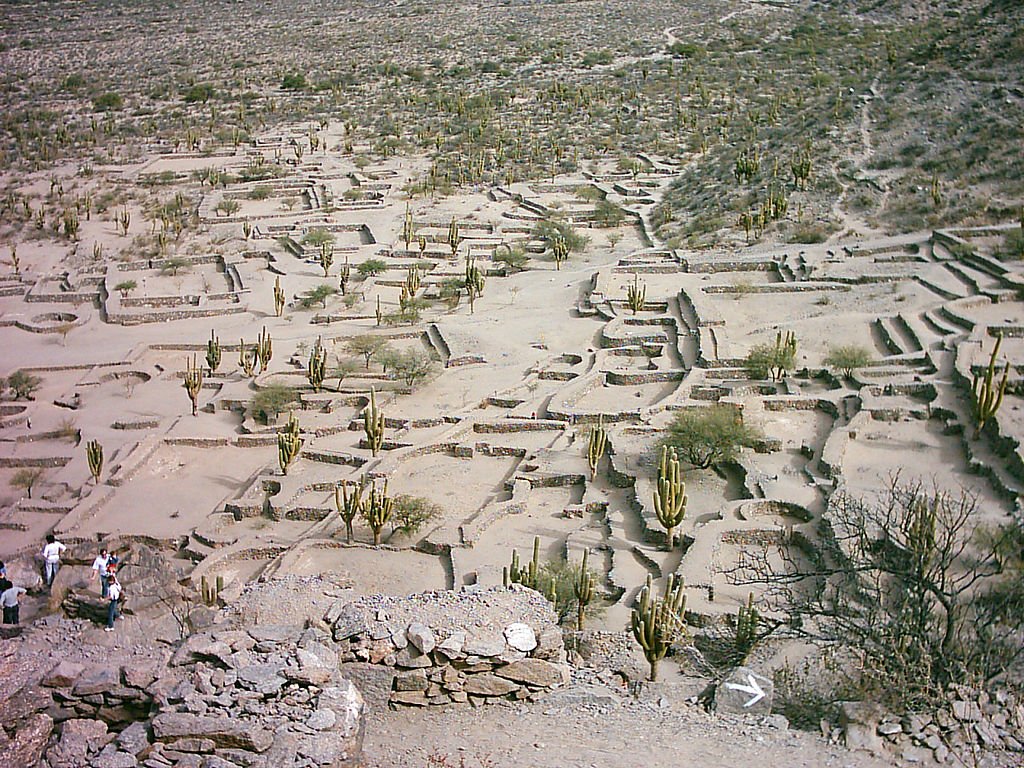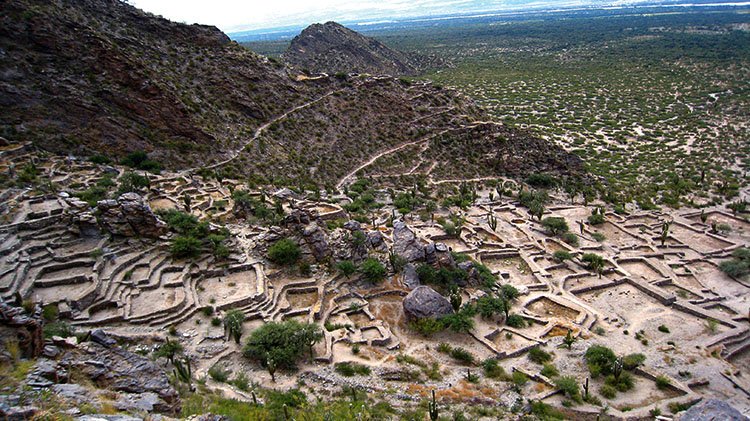Ancient Ruins Of Quilmes: Largest Pre-Colombian Settlement In Argentina
A. Sutherland - AncientPages.com - Once in the past, Quilmes was a great pre-Columbian city in northern Argentina. Brutal invasion by the Spaniards forced the Quilmes Indians to flee and abandon everything they owned. Before they left, they tried to defend their holy city, until the end.
Located in the Calchaquí Valleys, Tucumán Province, the ancient Quilmes ruins are the remains of the largest pre-Columbian settlement in Argentina.
The ancient city on Quilmes was once inhabited by 5,000 people. Image credit: Fernando Pascullo
The ruins were discovered in 1888 by Samuel Alejandro Lafone Quevedo, but it was first in 1897 these ancient structures were studied by the archaeologist Juan Bautista Ambrosetti.
It was an ancient city, occupying about 30 hectares with high population density, complex socio-cultural structures, and highly developed irrigation mechanisms. The area dates back to ca 850 AD and it is believed that about 5,000 people lived in the city.
The Quilmes people were an indigenous tribe of the Diaguita group in Argentina. They resisted the Inca invasions of the 15th century and continued to resist the Spaniards for 130 years until finally being defeated in 1667.
Quilmes was a fortress city, located at the altitude of 1850m, to which five thousand people could find protection when tribal attack threatened their quiet and peaceful existence. It is known that the Diaguitan people built the place; they were sophisticated with their own language, social structure, and weaponry. Its cultural zenith is dated to 900AD.
Ruins of the Quilmes civilization. Image credit: Alicia Nijdam-Jones.
They could protect themselves and Quilmes was almost impossible to conquer for thousands of years. Then, the situation changed when the Inca came and after them, the Spanish Conquistadors began to threaten the inhabitants of Quilmes.
When the Spanish conquistadors arrived the Quilmes Indians were more or less helpless, their resistance was insufficient but they fought as best as they could. At the end, there was only one option left: they had to escape the invaders.
Even today, the remains of Quilmes show some evidence of the people's clever defenses including narrow and sharply angled passageways with small entrances (barely wide enough for one person to go through). These entrances could be immediately barred with a single large rock.
To save themselves, they had to walk with only the minimum necessary supplies for more than 1200 km. They walked all the way until they came to the vicinity of the city of Buenos Aires. Hundreds of people died during this journey. Those who survived died later from diseases that were unknown to them.
The history of the city of Qilmes and its people is not forgotten. Today, there are only a few Quilmes left in Tucumán Province.
In 2009, the descendants of the ancient Quilmes took possession of the land. They now guide tourists across the area and tell the ancient history of this city and all people who once lived there.
The ruins of Quilmes are considered one of the most important archaeological locations in Argentina
Written by – A. Sutherland - AncientPages.com Senior Staff Writer
Copyright © AncientPages.com All rights reserved. This material may not be published, broadcast, rewritten or redistributed in whole or part without the express written permission of AncientPages.com
More From Ancient Pages
-
 Ancient DNA Provides Comprehensive Genomic History Of The “Cradle Of Civilization”
Archaeology | Oct 10, 2022
Ancient DNA Provides Comprehensive Genomic History Of The “Cradle Of Civilization”
Archaeology | Oct 10, 2022 -
 Bees Originated From An Ancient Supercontinent Millions Of Years Earlier Than Previously Thought
Evolution | Jul 31, 2023
Bees Originated From An Ancient Supercontinent Millions Of Years Earlier Than Previously Thought
Evolution | Jul 31, 2023 -
 More Than 2,000 Seal Impressions Found In The Ancient City Of Doliche
Archaeology | Nov 24, 2023
More Than 2,000 Seal Impressions Found In The Ancient City Of Doliche
Archaeology | Nov 24, 2023 -
 Mysterious 70-Million-Year-Old Underground Village And Magnificent Tower Of Eben-Ezer In Belgium
Featured Stories | Mar 20, 2017
Mysterious 70-Million-Year-Old Underground Village And Magnificent Tower Of Eben-Ezer In Belgium
Featured Stories | Mar 20, 2017 -
 5,000-Year-Old Arminghall Henge In Norwich Reveals Some Of Its Secrets
Archaeology | Dec 20, 2022
5,000-Year-Old Arminghall Henge In Norwich Reveals Some Of Its Secrets
Archaeology | Dec 20, 2022 -
 Cupbearer Was Privy To Conversations And Political Secrets Hidden Behind Closed Doors
Featured Stories | Oct 5, 2020
Cupbearer Was Privy To Conversations And Political Secrets Hidden Behind Closed Doors
Featured Stories | Oct 5, 2020 -
 Remarkable ‘Hipposandals’ Found At Vindolanda
Archaeology | Aug 18, 2018
Remarkable ‘Hipposandals’ Found At Vindolanda
Archaeology | Aug 18, 2018 -
 Fearsome Sekhmet: Lion-Headed Egyptian Goddess And Sister Of Ptah
Egyptian Mythology | May 13, 2020
Fearsome Sekhmet: Lion-Headed Egyptian Goddess And Sister Of Ptah
Egyptian Mythology | May 13, 2020 -
 Patara’s 2,400-Year-Old Ancient Kitchen And ‘Women’s Room’ Unearthed
Archaeology | Oct 7, 2020
Patara’s 2,400-Year-Old Ancient Kitchen And ‘Women’s Room’ Unearthed
Archaeology | Oct 7, 2020 -
 Amazing Time Capsule – La Roche-Cotard Cave Sealed For 50,000-Years Offers Evidence Neanderthals Were The World’s First Artists
Archaeology | Nov 22, 2023
Amazing Time Capsule – La Roche-Cotard Cave Sealed For 50,000-Years Offers Evidence Neanderthals Were The World’s First Artists
Archaeology | Nov 22, 2023 -
 Mysterious Ancient Star People Of The Secret Power
Civilizations | Sep 12, 2018
Mysterious Ancient Star People Of The Secret Power
Civilizations | Sep 12, 2018 -
 Curious Pre-Columbian Clay Figurines With Smiling Faces From Veracruz
Artifacts | Jan 29, 2018
Curious Pre-Columbian Clay Figurines With Smiling Faces From Veracruz
Artifacts | Jan 29, 2018 -
 Lady Cao – Moche Queen Who Re-Wrote Ancient History
Civilizations | Jan 12, 2018
Lady Cao – Moche Queen Who Re-Wrote Ancient History
Civilizations | Jan 12, 2018 -
 World Map Of Neanderthal And Denisovan DNA In Modern Humans
DNA | Apr 13, 2023
World Map Of Neanderthal And Denisovan DNA In Modern Humans
DNA | Apr 13, 2023 -
 Enigmatic Bronze Age Fulacht Fiadh: ‘Kitchens’ Of The Legendary Irish Warriors
Civilizations | Nov 26, 2018
Enigmatic Bronze Age Fulacht Fiadh: ‘Kitchens’ Of The Legendary Irish Warriors
Civilizations | Nov 26, 2018 -
 Mysterious Ancient Oil Lamps In Ohio And Wisconsin – Evidence Of Pre-Columbian Contact?
Artifacts | Dec 20, 2017
Mysterious Ancient Oil Lamps In Ohio And Wisconsin – Evidence Of Pre-Columbian Contact?
Artifacts | Dec 20, 2017 -
 Number 13: Coincidence Or Bad Luck – Are We Still Superstitious?
Featured Stories | Dec 9, 2020
Number 13: Coincidence Or Bad Luck – Are We Still Superstitious?
Featured Stories | Dec 9, 2020 -
 Golosov Ravine – Mysterious Time-Warping Mist Causing Unexplained Disappearances And The Ancient Shrine Of God Veles
Featured Stories | Jul 3, 2021
Golosov Ravine – Mysterious Time-Warping Mist Causing Unexplained Disappearances And The Ancient Shrine Of God Veles
Featured Stories | Jul 3, 2021 -
 Unsolved Prehistoric Enigma Of Sophisticated Spiro People And Their Mysterious Mounds
Civilizations | Oct 25, 2018
Unsolved Prehistoric Enigma Of Sophisticated Spiro People And Their Mysterious Mounds
Civilizations | Oct 25, 2018 -
 Ancient Treasure Hidden In Perplexing Secret Underground Labyrinth In France – Dangerous Search – Part 1
Featured Stories | Jan 16, 2020
Ancient Treasure Hidden In Perplexing Secret Underground Labyrinth In France – Dangerous Search – Part 1
Featured Stories | Jan 16, 2020


